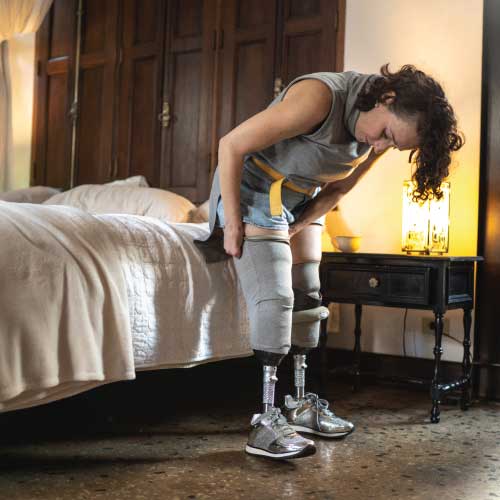No Link Found Between BMI and Skin Problems in Persons With Lower-Limb Loss—New Study
A new study sought to determine the prevalence of obesity in Dutch individuals with lower-limb loss. The study was published in the BMC Musculoskeletal Disorders journal in September 2021. The researchers also investigated the link between body mass index (BMI), body weight, and skin problems in the residual limb with the frequency of prosthetic repairs.

The general weight limit for prosthetic components is 100 kg. Having a prosthetic limb that can withstand the user's body weight is crucial for individuals with lower-limb loss. A previous study from the UK found that about 14% of persons with lower-limb loss exceed 100 kg. In 3% of those individuals, body weight exceeds the weight limit of most prosthetic legs, which increases their risk of falling and prosthetic failure.
The UK study also found that the frequency of prosthetic repairs increased with body weight and suggested that obesity is associated with impaired wound healing after limb loss as well as problems with prosthetic fitting.
The new Dutch study sought to determine if the UK study's findings apply to the Dutch population.
The study
The researchers gathered data by surveying the height and bodyweight of participants at two orthopedic workshops, Orthopedietechniek and OIM Orthopedie. The team also used questionnaires to assess skin problems in the residual limb as well as the factors linked with the skin problems.
The research team analyzed the following factors for their possible association with residual limb skin problems and prosthetic repairs: age, BMI, body weight, the reason for limb loss, walking aid use, and walking distance outdoors.
A total of 413 persons agreed to participate in the study; 70% were male, and the majority had below-knee limb loss. The age of the participants ranged from 47 to 77, and the participants' median time since losing their limb was 12.4 years. The majority of the participants lost their limbs to trauma and diabetes. Of the participants, 28% were obese, 39% were overweight, and 13% weighed over 100 kg, the typical weight limit for prosthetic components.
Skin problems
Out of the total number of study participants, 77% reported experiencing one or more skin problems in the previous month, while 32% had a severe skin problem. The researchers found that the participants who reported having skin problems were six years younger on average than those without skin problems. Meanwhile, the participants with severe skin problems had a lower BMI than those without.
The participants who reported having skin problems were six years younger on average than those without skin problems. The participants with severe skin problems also had a lower BMI than those without.
The researchers didn't find any significant link between skin problems and the reason for limb loss. However, in a posthoc analysis, the team found that participants who lost a limb to diabetes or peripheral arterial disease (PAD) had fewer skin problems than participants who lost a limb to trauma.
Participants who lost a limb to diabetes or peripheral arterial disease (PAD) had lesser skin problems than those who lost a limb to trauma.
Prosthetic repairs
The researchers also didn't find any link between body weight, BMI, age, walking distance outdoors, and the number of visits to the orthopedic workshop. Participants who used a walking aid visited their prosthetic facility more frequently than those who didn't use one.
The participants increased their visits to their prosthetic facility depending on the reason for limb loss. Limb loss due to malignancy led to the most prosthetic appointments, and the number of visits increased with skin problems.
Limb loss due to malignancy led to the most orthopedic appointments, and the number of visits increased with skin problems.
Bottom line
The researchers didn't find any link between body weight, BMI, residual limb skin problems, and the frequency of prosthetic repairs.
Two-thirds of Dutch individuals with lower-limb loss have an above-normal BMI, with almost one-third being obese. However, the researchers didn't find any link between body weight, BMI, skin problems in the residual limb, and the frequency of prosthetic repairs.
However, the research team still recommends carefully assessing individuals with lower-limb loss as obesity has a well-known adverse effect on overall health.










































































